List of mammals of Myanmar
This is a list of the mammal species recorded in Myanmar. There are 257 mammal species in Myanmar, of which four are critically endangered, ten are endangered, twenty-six are vulnerable, and two are near threatened.[1]
The following tags are used to highlight each species' conservation status as assessed by the International Union for Conservation of Nature:
| EX | Extinct | No reasonable doubt that the last individual has died. |
| EW | Extinct in the wild | Known only to survive in captivity or as a naturalized populations well outside its previous range. |
| CR | Critically endangered | The species is in imminent risk of extinction in the wild. |
| EN | Endangered | The species is facing an extremely high risk of extinction in the wild. |
| VU | Vulnerable | The species is facing a high risk of extinction in the wild. |
| NT | Near threatened | The species does not meet any of the criteria that would categorise it as risking extinction but it is likely to do so in the future. |
| LC | Least concern | There are no current identifiable risks to the species. |
| DD | Data deficient | There is inadequate information to make an assessment of the risks to this species. |
Order: Artiodactyla (even-toed ungulates)[]
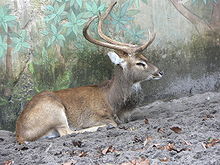
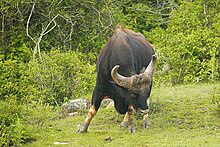

The even-toed ungulates are ungulates whose weight is borne about equally by the third and fourth toes, rather than mostly or entirely by the third as in perissodactyls. There are about 220 artiodactyl species, including many that are of great economic importance to humans.
- Family: Bovidae (cattle, antelope, sheep, goats)
- Subfamily: Bovinae
- Subfamily: Caprinae
- Genus: Pseudois
- Bharal, P. nayaur LC[9]
- Family: Moschidae (musk deer)
- Genus: Moschus
- Black musk deer, M. fuscus EN[10]
- Genus: Moschus
- Family: Cervidae (deer)
- Subfamily: Cervinae
- Genus: Rucervus
- Eld's deer, R. eldii EN[11]
- Genus: Rusa
- Sambar deer, R. unicolor VU[12]
- Genus: Rucervus
- Subfamily: Muntiacinae
- Genus: Elaphodus
- Tufted deer, E. cephalophus DD
- Genus: Muntiacus
- Hairy-fronted muntjac, M. crinifrons VU
- Fea's muntjac, M. feae DD
- Gongshan muntjac, M. gongshanensis DD
- Indian muntjac, M. muntjak LC[13]
- Leaf deer, M. putaoensis DD
- Genus: Elaphodus
- Subfamily: Cervinae
- Family: Suidae (pigs)
- Subfamily: Suinae
- Genus: Sus
- Wild boar, S. scrofa LC[14]
- Genus: Sus
- Subfamily: Suinae
- Family: Tragulidae (chevrotains)
- Genus: Tragulus
- Lesser mouse deer, T. kanchil LC
- Greater mouse deer, T. napu LC
- Genus: Tragulus
Order: Carnivora (carnivorans)[]
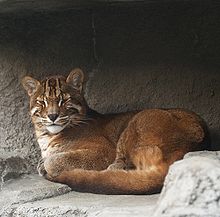



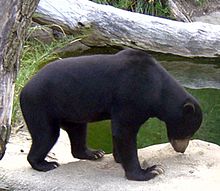


There are over 260 species of carnivorans, the majority of which feed primarily on meat. They have a characteristic skull shape and dentition.
- Suborder: Feliformia
- Family: Felidae (cats)
- Subfamily: Felinae
- Subfamily: Pantherinae
- Family: Viverridae
- Subfamily: Paradoxurinae
- Genus: Arctictis
- Binturong, A. binturong VU[24]
- Genus: Arctogalidia
- Small-toothed palm civet, A. trivirgata LC[25]
- Genus: Paguma
- Masked palm civet, P. larvata LC[26]
- Genus: Paradoxurus
- Asian palm civet, P. hermaphroditus LC[27]
- Genus: Arctictis
- Subfamily: Hemigalinae
- Genus: Hemigalus
- Banded palm civet, H. derbyanus NT[28]
- Genus: Hemigalus
- Subfamily: Prionodontinae
- Genus: Prionodon
- Banded linsang, P. linsang LC[29]
- Spotted linsang, P. pardicolor LC[30]
- Genus: Prionodon
- Subfamily: Viverrinae
- Genus: Viverra
- Large-spotted civet, V. megaspila EN[31]
- Large Indian civet, V. zibetha LC[32]
- Genus: Viverricula
- Small Indian civet, V. indica LC[33]
- Genus: Viverra
- Subfamily: Paradoxurinae
- Family: Herpestidae (mongooses)
- Genus: Urva
- Small Indian mongoose, U. auropunctata LC[34]
- Javan mongoose, U. javanica LC[35]
- Crab-eating mongoose, U. urva LC[36]
- Genus: Urva
- Family: Felidae (cats)
- Suborder: Caniformia
- Family: Ailuridae
- Genus: Ailurus
- Red panda, A. fulgens EN[37]
- Genus: Ailurus
- Family: Canidae (dogs, foxes)
- Family: Ursidae (bears)
- Family: Mustelidae (mustelids)
- Genus: Aonyx
- Asian small-clawed otter, A. cinereus VU[44]
- Genus: Arctonyx
- Greater hog badger, A. collaris VU[45]
- Northern hog badger, A. albogularis LC[46]
- Genus: Lutra
- Eurasian otter, L. lutra NT[47]
- Genus: Lutrogale
- Smooth-coated otter, L. perspicillata VU[48]
- Genus: Martes
- Yellow-throated marten, M. flavigula LC[49]
- Genus: Melogale
- Genus: Mustela
- Yellow-bellied weasel, M. kathiah LC[52]
- Siberian weasel, M. sibirica LC[53]
- Back-striped weasel, M. strigidorsa LC[54]
- Genus: Aonyx
- Family: Ailuridae
Order: Cetacea (whales)[]
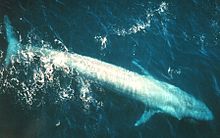

The order Cetacea includes whales, dolphins and porpoises. They are the mammals most fully adapted to aquatic life with a spindle-shaped nearly hairless body, protected by a thick layer of blubber, and forelimbs and tail modified to provide propulsion underwater.
- Suborder: Mysticeti
- Family: Balaenopteridae
- Subfamily: Balaenopterinae
- Genus: Balaenoptera
- Common minke whale, B. acutorostrata LC[55]
- Bryde's whale, Balaenoptera brydei DD
- Eden's whale, Balaenoptera edeni DD
- Blue whale, Balaenoptera musculus EN
- Fin whale, Balaenoptera physalus EN
- Genus: Megaptera
- Humpback whale, Megaptera novaeangliae LC
- Genus: Balaenoptera
- Subfamily: Balaenopterinae
- Family: Balaenopteridae
- Suborder: Odontoceti
- Superfamily: Platanistoidea
- Family: Physeteridae
- Genus: Physeter
- Sperm whale, Physeter macrocephalus VU
- Genus: Physeter
- Family: Phocoenidae
- Genus: Neophocaena
- Finless porpoise, Neophocaena phocaenoides DD
- Genus: Neophocaena
- Family: Kogiidae
- Genus: Kogia
- Pygmy sperm whale, K. breviceps DD[56]
- Dwarf sperm whale, Kogia sima DD
- Genus: Kogia
- Family: Ziphiidae
- Subfamily: Hyperoodontinae
- Genus: Indopacetus
- Tropical bottlenose whale, Indopacetus pacificus DD
- Genus: Mesoplodon
- Blainville's beaked whale, Mesoplodon densirostris DD
- Ginkgo-toothed beaked whale, Mesoplodon ginkgodens DD
- Genus: Indopacetus
- Subfamily: Ziphiinae
- Genus: Ziphius
- Cuvier's beaked whale, Ziphius cavirostris LC
- Genus: Ziphius
- Subfamily: Hyperoodontinae
- Family: Delphinidae (marine dolphins)
- Genus: Steno
- Rough-toothed dolphin, Steno bredanensis DD
- Genus: Sousa
- Indo-Pacific humpbacked dolphin, Sousa chinensis DD
- Genus: Tursiops
- Indo-Pacific bottlenose dolphin, Tursiops aduncus DD
- Common bottlenose dolphin, Tursiops truncatus LC
- Genus: Stenella
- Pantropical spotted dolphin, Stenella attenuata
- Striped dolphin, Stenella coeruleoalba LC
- Spinner dolphin, Stenella longirostris
- Genus: Lagenodelphis
- Fraser's dolphin, Lagenodelphis hosei DD
- Genus: Grampus
- Risso's dolphin, Grampus griseus DD
- Genus: Feresa
- Pygmy killer whale, Feresa attenuata DD
- Genus: Pseudorca
- False killer whale, Pseudorca crassidens DD
- Genus: Globicephala
- Short-finned pilot whale, Globicephala macrorhynchus
- Genus: Orcaella
- Irrawaddy dolphin, O. brevirostris EN[57]
- Genus: Orcinus
- Genus: Peponocephala
- Melon-headed whale, Peponocephala electra DD
- Genus: Steno
- Family: Physeteridae
- Superfamily: Platanistoidea
Order: Chiroptera (bats)[]

The bats' most distinguishing feature is that their forelimbs are developed as wings, making them the only mammals capable of flight. Bat species account for about 20% of all mammals.
- Family: Pteropodidae (flying foxes, Old World fruit bats)
- Subfamily: Pteropodinae
- Genus: Cynopterus
- Lesser short-nosed fruit bat, C. brachyotis LC[59]
- Greater short-nosed fruit bat, C. sphinx LC
- Genus: Pteropus
- Indian flying fox, P. giganteus LC[60]
- Small flying-fox, P. hypomelanus
- Pteropus, P. vampyrus
- Genus: Rousettus
- Geoffroy's rousette, Rousettus amplexicaudatus
- Rousettus leschenaulti
- Genus: Sphaerias
- Blanford's fruit bat, Sphaerias blanfordi
- Genus: Cynopterus
- Subfamily: Macroglossinae
- Genus: Eonycteris
- Lesser dawn bat, Eonycteris spelaea
- Genus: Macroglossus
- Macroglossus sobrinus
- Genus: Eonycteris
- Subfamily: Pteropodinae
- Family: Vespertilionidae
- Subfamily: Kerivoulinae
- Genus: Kerivoula
- Hardwicke's woolly bat, Kerivoula hardwickii
- Genus: Kerivoula
- Subfamily: Myotinae
- Genus: Myotis
- Hairy-faced bat, Myotis annectans
- Large myotis, Myotis chinensis
- Lesser large-footed bat, Myotis hasseltii
- Horsfield's bat, Myotis horsfieldii
- Burmese whiskered bat, Myotis montivagus
- Whiskered myotis, Myotis muricola
- Whiskered bat, M. mystacinus LC[61]
- Genus: Myotis
- Subfamily: Vespertilioninae
- Genus: Arielulus
- Black-gilded pipistrelle, Arielulus circumdatus
- Genus: Eptesicus
- Thick-eared bat, Eptesicus pachyotis
- Genus: Eudiscopus
- Disk-footed bat, Eudiscopus denticulus
- Genus: Falsistrellus
- Chocolate pipistrelle, Falsistrellus affinis
- Genus: Glischropus
- Common thick-thumbed bat, Glischropus tylopus
- Genus: Hesperoptenus
- Blanford's bat, Hesperoptenus blanfordi
- Tickell's bat, Hesperoptenus tickelli
- Genus: Hypsugo
- Anthony's pipistrelle, Hypsugo anthonyi CR
- Cadorna's pipistrelle, Hypsugo cadornae
- Joffre's pipistrelle, Hypsugo joffrei CR
- Burma pipistrelle, Hypsugo lophurus DD
- Savi's pipistrelle, H. savii LC[62]
- Genus: Pipistrellus
- Kelaart's pipistrelle, Pipistrellus ceylonicus
- Indian pipistrelle, Pipistrellus coromandra
- Java pipistrelle, Pipistrellus javanicus
- Mount Popa pipistrelle, Pipistrellus paterculus
- Pegu pipistrelle, Pipistrellus peguensis DD
- Common pipistrelle, Pipistrellus pipistrellus LC
- Genus: Scotomanes
- Harlequin bat, Scotomanes ornatus
- Genus: Tylonycteris
- Lesser bamboo bat, Tylonycteris pachypus
- Greater bamboo bat, Tylonycteris robustula
- Genus: Arielulus
- Subfamily: Murininae
- Genus: Harpiocephalus
- Greater hairy-winged bat, Harpiocephalus mordax
- Genus: Murina
- Little tube-nosed bat, Murina aurata
- Murina cyclotis
- Hutton's tube-nosed bat, Murina huttoni
- Scully's tube-nosed bat, Murina tubinaris
- Genus: Harpiocephalus
- Subfamily: Miniopterinae
- Genus: Miniopterus
- Western bent-winged bat, Miniopterus magnater
- Common bent-wing bat, M. schreibersii VU[63]
- Genus: Miniopterus
- Subfamily: Kerivoulinae
- Family: Rhinopomatidae
- Genus: Rhinopoma
- Lesser mouse-tailed bat, Rhinopoma hardwickei LC
- Greater mouse-tailed bat, Rhinopoma microphyllum LC
- Genus: Rhinopoma
- Family: Molossidae
- Genus: Chaerephon
- Wrinkle-lipped free-tailed bat, Chaerephon plicata
- Genus: Chaerephon
- Family: Emballonuridae
- Genus: Saccolaimus
- Naked-rumped pouched bat, Saccolaimus saccolaimus
- Genus: Taphozous
- Long-winged tomb bat, Taphozous longimanus
- Black-bearded tomb bat, Taphozous melanopogon
- Naked-rumped tomb bat, Taphozous nudiventris LC
- Theobald's tomb bat, Taphozous theobaldi
- Genus: Saccolaimus
- Family: Nycteridae
- Genus: Nycteris
- Malayan slit-faced bat, Nycteris tragata
- Genus: Nycteris
- Family: Megadermatidae
- Genus: Megaderma
- Greater false vampire bat, Megaderma lyra
- Lesser false vampire bat, Megaderma spasma
- Genus: Megaderma
- Family: Rhinolophidae
- Subfamily: Rhinolophinae
- Genus: Rhinolophus
- Intermediate horseshoe bat, Rhinolophus affinis
- Croslet horseshoe bat, Rhinolophus coelophyllus
- Blyth's horseshoe bat, Rhinolophus lepidus
- Woolly horseshoe bat, Rhinolophus luctus
- Malayan horseshoe bat, Rhinolophus malayanus
- Pearson's horseshoe bat, Rhinolophus pearsoni
- Least horseshoe bat, Rhinolophus pusillus
- Rufous horseshoe bat, Rhinolophus rouxi
- Shamel's horseshoe bat, Rhinolophus shameli
- Little Nepalese horseshoe bat, Rhinolophus subbadius DD
- Thomas's horseshoe bat, Rhinolophus thomasi
- Trefoil horseshoe bat, Rhinolophus trifoliatus
- Dobson's horseshoe bat, Rhinolophus yunanensis
- Genus: Rhinolophus
- Subfamily: Hipposiderinae
- Genus: Aselliscus
- Stoliczka's trident bat, Aselliscus stoliczkanus
- Genus: Coelops
- Tail-less leaf-nosed bat, Coelops frithii
- Genus: Hipposideros
- Great roundleaf bat, Hipposideros armiger LC
- Dusky roundleaf bat, Hipposideros ater LC
- Ashy roundleaf bat, Hipposideros cineraceus LC
- Diadem roundleaf bat, Hipposideros diadema LC
- Fulvus roundleaf bat, Hipposideros fulvus
- Intermediate roundleaf bat, Hipposideros larvatus
- Shield-faced roundleaf bat, Hipposideros lylei
- Pomona roundleaf bat, Hipposideros pomona
- Pratt's roundleaf bat, Hipposideros pratti
- Genus: Aselliscus
- Subfamily: Rhinolophinae
Order: Dermoptera (colugos)[]
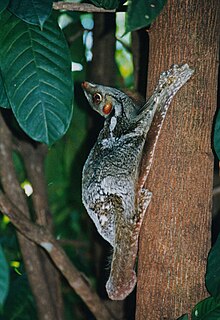
The two species of colugos make up the order Dermoptera. They are arboreal gliding mammals found in Southeast Asia.
- Family: Cynocephalidae (flying lemurs)
- Genus: Galeopterus
- Sunda flying lemur, G. variegatus LC[64]
- Genus: Galeopterus
Order: Erinaceomorpha (hedgehogs and gymnures)[]
The order Erinaceomorpha contains a single family, Erinaceidae, which comprise the hedgehogs and gymnures. The hedgehogs are easily recognised by their spines while gymnures look more like large rats.
- Family: Erinaceidae (hedgehogs)
- Subfamily: Galericinae
- Genus: Echinosorex
- Gymnure, E. gymnura LC
- Genus: Hylomys
- Shrew gymnure, H. sinensis NT
- Short-tailed gymnure, H. suillus LC
- Genus: Echinosorex
- Subfamily: Galericinae
Order: Lagomorpha (lagomorphs)[]
The lagomorphs comprise two families, Leporidae (hares and rabbits), and Ochotonidae (pikas). Though they can resemble rodents, and were classified as a superfamily in that order until the early 20th century, they have since been considered a separate order. They differ from rodents in a number of physical characteristics, such as having four incisors in the upper jaw rather than two.
- Family: Ochotonidae (pikas)
- Genus: Ochotona
- Forrest's pika, O. forresti NT
- Genus: Ochotona
- Family: Leporidae (rabbits, hares)
- Genus: Lepus
- Burmese hare, L. peguensis LC
- Genus: Lepus
Order: Perissodactyla (odd-toed ungulates)[]
The odd-toed ungulates are browsing and grazing mammals. They are usually large to very large, and have relatively simple stomachs and a large middle toe.
- Family: Tapiridae (tapirs)
- Genus: Acrocodia
- Malayan tapir, A. indica EN[65]
- Genus: Acrocodia
Order: Pholidota (pangolins)[]

The order Pholidota comprises the eight species of pangolin. Pangolins are anteaters and have the powerful claws, elongated snout and long tongue seen in the other unrelated anteater species.
- Family: Manidae
Order: Primates[]

The order Primates contains humans and their closest relatives: lemurs, lorisoids, monkeys, and apes.
- Suborder: Strepsirrhini
- Infraorder: Lemuriformes
- Superfamily: Lorisoidea
- Infraorder: Lemuriformes
- Suborder: Haplorhini
- Infraorder: Simiiformes
- Parvorder: Catarrhini
- Superfamily: Cercopithecoidea
- Family: Cercopithecidae (Old World monkeys)
- Genus: Macaca
- Stump-tailed macaque, M. arctoides VU[69]
- Assam macaque, M. assamensis NT[70]
- Crab-eating macaque, M. fascicularis VU[71]
- Northern pigtail macaque, M. leonina VU
- Rhesus macaque, M. mulatta LC[72]
- Genus: Macaca
- Family: Cercopithecidae (Old World monkeys)
- Superfamily: Cercopithecoidea
- Parvorder: Catarrhini
- Infraorder: Simiiformes
- Subfamily: Colobinae
- Genus: Trachypithecus
- Tenasserim lutung, T. barbei EN [73]
- , T. crepusculus EN [73]
- Dusky leaf monkey, T. obscurus EN[74]
- Capped langur, T. pileatus EN
- Phayre's langur T. phayrei[73]
- Shan State langur T. melamera[73]
- Shortridge's langur T. shortridgei[73]
- Popa langur T. popa[73][75]
- Genus: Presbytis
- Raffles' banded langur, P. femoralis NT [73][76]
- Genus: Rhinopithecus
- Myanmar snub-nosed monkey, R. strykeri CR [77]
- Genus: Trachypithecus
- Subfamily: Colobinae
- Superfamily: Hominoidea
- Family: Hylobatidae (gibbons)
- Genus: Hoolock
- Western hoolock gibbon, H. hoolock EN[78]
- Eastern hoolock gibbon, H. leuconedys VU[79]
- Skywalker hoolock gibbon, H. tianxing EN[80]
- Genus: Hylobates
- Lar gibbon, H. lar EN[81]
- Genus: Hoolock
- Family: Hylobatidae (gibbons)
Order: Proboscidea (elephants)[]
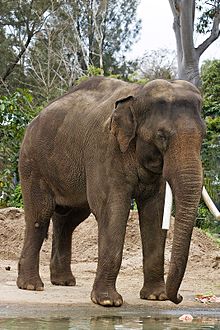
The elephants comprise three living species and are the largest living land animals.
- Family: Elephantidae (elephants)
- Genus: Elephas
- Asian elephant, E. maximus EN[82]
- Genus: Elephas
Order: Rodentia (rodents)[]

Rodents make up the largest order of mammals, with over 40% of mammalian species. They have two incisors in the upper and lower jaw which grow continually and must be kept short by gnawing. Most rodents are small though the capybara can weigh up to 45 kg (99 lb).
- Suborder: Hystricognathi
- Family: Hystricidae (Old World porcupines)
- Genus: Atherurus
- Asiatic brush-tailed porcupine, Atherurus macrourus
- Genus: Hystrix
- Malayan porcupine, H. brachyura LC[83]
- Genus: Atherurus
- Family: Hystricidae (Old World porcupines)
- Suborder: Sciurognathi
- Family: Sciuridae (squirrels)
- Subfamily: Ratufinae
- Genus: Ratufa
- Black giant squirrel, Ratufa bicolor
- Genus: Ratufa
- Subfamily: Sciurinae
- Tribe: Pteromyini
- Genus: Belomys
- Hairy-footed flying squirrel, Belomys pearsonii
- Genus: Hylopetes
- Particolored flying squirrel, Hylopetes alboniger
- Indochinese flying squirrel, Hylopetes phayrei
- Red-cheeked flying squirrel, Hylopetes spadiceus
- Genus: Petaurista
- Spotted giant flying squirrel, Petaurista elegans
- Red giant flying squirrel, Petaurista petaurista
- Indian giant flying squirrel, Petaurista philippensis
- Genus: Petinomys
- Temminck's flying squirrel, Petinomys setosus
- Vordermann's flying squirrel, Petinomys vordermanni
- Genus: Belomys
- Tribe: Pteromyini
- Subfamily: Callosciurinae
- Genus: Callosciurus
- Gray-bellied squirrel, Callosciurus caniceps
- Callosciurus, Callosciurus erythraeus
- Finlayson's squirrel, Callosciurus finlaysonii
- Phayre's squirrel, Callosciurus phayrei
- Irrawaddy squirrel, Callosciurus pygerythrus VU
- Anderson's squirrel, Callosciurus quinquestriatus VU
- Genus: Dremomys
- Orange-bellied Himalayan squirrel, Dremomys lokriah
- Perny's long-nosed squirrel, Dremomys pernyi
- Asian red-cheeked squirrel, Dremomys rufigenis
- Genus: Menetes
- Berdmore's ground squirrel, Menetes berdmorei
- Genus: Tamiops
- Himalayan striped squirrel, Tamiops macclellandi
- Swinhoe's striped squirrel, Tamiops swinhoei
- Genus: Callosciurus
- Subfamily: Ratufinae
- Family: Spalacidae
- Subfamily: Rhizomyinae
- Genus: Cannomys
- Lesser bamboo rat, Cannomys badius
- Genus: Rhizomys
- Hoary bamboo rat, Rhizomys pruinosus
- Chinese bamboo rat, Rhizomys sinensis
- Large bamboo rat, Rhizomys sumatrensis
- Genus: Cannomys
- Subfamily: Rhizomyinae
- Family: Cricetidae
- Subfamily: Arvicolinae
- Genus: Eothenomys
- Père David's vole, Eothenomys melanogaster
- Genus: Microtus
- Chinese scrub vole, Microtus irene
- Genus: Eothenomys
- Subfamily: Arvicolinae
- Family: Muridae (mice, rats, voles, gerbils, hamsters)
- Subfamily: Murinae
- Genus: Apodemus
- South China field mouse, Apodemus draco
- Genus: Bandicota
- Lesser bandicoot rat, Bandicota bengalensis
- Greater bandicoot rat, Bandicota indica
- Savile's bandicoot rat, Bandicota savilei
- Genus: Berylmys
- Small white-toothed rat, Berylmys berdmorei
- Bower's white-toothed rat, Berylmys bowersi
- Kenneth's white-toothed rat, Berylmys mackenziei
- Manipur white-toothed rat, Berylmys manipulus
- Genus: Chiromyscus
- Fea's tree rat, Chiromyscus chiropus
- Genus: Chiropodomys
- Pencil-tailed tree mouse, Chiropodomys gliroides
- Genus: Hapalomys
- Marmoset rat, Hapalomys longicaudatus EN
- Genus: Leopoldamys
- Edwards's long-tailed giant rat, Leopoldamys edwardsi
- Genus: Maxomys
- Red spiny rat, Maxomys surifer
- Genus: Millardia
- Miss Ryley's soft-furred rat, Millardia kathleenae
- Genus: Mus
- Little Indian field mouse, Mus booduga
- Fawn-colored mouse, Mus cervicolor
- Cook's mouse, Mus cookii
- Gairdner's shrewmouse, Mus pahari
- Shortridge's mouse, Mus shortridgei
- Genus: Niviventer
- Brahma white-bellied rat, Niviventer brahma
- Chinese white-bellied rat, Niviventer confucianus
- Dark-tailed tree rat, Niviventer cremoriventer
- Smoke-bellied rat, Niviventer eha
- Lang Bian white-bellied rat, Niviventer langbianis
- Tenasserim white-bellied rat, Niviventer tenaster
- Genus: Rattus
- Brown rat, R. norvegicus LC introduced[84]
- Polynesian rat, R. exulans
- Himalayan field rat, R. nitidus
- Sikkim rat, R. sikkimensis
- Tanezumi rat, R. tanezumi
- Genus: Sundamys
- Müller's giant Sunda rat, S. muelleri
- Genus: Vandeleuria
- Asiatic long-tailed climbing mouse, V. oleracea
- Genus: Vernaya
- Red climbing mouse, V. fulva VU
- Genus: Apodemus
- Subfamily: Murinae
- Family: Sciuridae (squirrels)
Order: Scandentia (treeshrews)[]
The treeshrews are small mammals native to the tropical forests of Southeast Asia. Although called treeshrews, they are not true shrews and are not all arboreal.
- Family: Tupaiidae (tree shrews)
- Genus: Tupaia
- Northern treeshrew, T. belangeri LC[85]
- Genus: Tupaia
Order: Sirenia (manatees and dugongs)[]

- Family: Dugongidae
- Genus: Dugong
- Dugong, D. dugon VU[86]
- Genus: Dugong
Order: Soricomorpha (shrews, moles, and solenodons)[]
The "shrew-forms" are insectivorous mammals. The shrews and solenodons closely resemble mice while the moles are stout-bodied burrowers.
- Family: Soricidae (shrews)
- Subfamily: Crocidurinae
- Genus: Crocidura
- Grey shrew, C. attenuata LC
- Southeast Asian shrew, C. fuliginosa LC
- Genus: Suncus
- Etruscan shrew, S. etruscus LC
- Asian house shrew, S. murinus LC[87]
- Genus: Crocidura
- Subfamily: Soricinae
- Tribe:
- Genus: Anourosorex
- Mole shrew, A. squamipes LC
- Genus: Anourosorex
- Tribe: Blarinellini
- Genus: Blarinella
- Southern short-tailed shrew, B. wardi LC
- Genus: Blarinella
- Tribe: Nectogalini
- Genus: Chimarrogale
- Himalayan water shrew, C. himalayica LC
- Styan's water shrew, C. styani LC
- Genus: Nectogale
- Elegant water shrew, N. elegans LC
- Genus: Soriculus
- Hodgson's brown-toothed shrew, S. caudatus LC
- Long-tailed brown-toothed shrew, S. leucops LC
- Long-tailed mountain shrew, S. macrurus LC
- Himalayan shrew, S. nigrescens LC
- Lowe's shrew, S. parca LC
- Genus: Chimarrogale
- Tribe: Soricini
- Genus: Sorex
- Lesser striped shrew, S. bedfordiae LC
- Genus: Sorex
- Tribe:
- Subfamily: Crocidurinae
- Family: Talpidae (moles)
- Subfamily: Talpinae
- Tribe: Scaptonychini
- Genus: Scaptonyx
- Long-tailed mole, S. fusicaudus LC
- Genus: Scaptonyx
- Tribe: Talpini
- Genus: Parascaptor
- White-tailed mole, P. leucura LC
- Genus: Parascaptor
- Tribe: Scaptonychini
- Subfamily: Uropsilinae
- Genus: Uropsilus
- Gracile shrew mole, U. gracilis LC
- Genus: Uropsilus
- Subfamily: Talpinae
Locally extinct[]
The following species are locally extinct in the country:
- Indian hog deer, Axis porcinus possibly extirpated[88]
- Sumatran rhinoceros, Dicerorhinus sumatrensis[89]
- Hairy-nosed otter, Lutra sumatrana[90]
- Javan rhinoceros, Rhinoceros sondaicus[91]
See also[]
- Wildlife of Myanmar
- List of chordate orders
- Lists of mammals by region
- List of prehistoric mammals
- Mammal classification
- List of mammals described in the 2000s
References[]
- ^ This list is derived from the IUCN Red List which lists species of mammals and includes those mammals that have recently been classified as extinct (since 1500 AD). The taxonomy and naming of the individual species is based on those used in existing Wikipedia articles as of 21 May 2007 and supplemented by the common names and taxonomy from the IUCN, Smithsonian Institution, or University of Michigan where no Wikipedia article was available.
- ^ Duckworth, J. W.; Sankar, K.; Williams, A. C.; Samba Kumar, N. & Timmins, R. J. (2016). "Bos gaurus". IUCN Red List of Threatened Species. 2016: e.T2891A46363646.
- ^ Gardner, P.; Hedges, S.; Pudyatmoko, S.; Gray, T.N.E. & Timmins, R.J. (2016). "Bos javanicus". IUCN Red List of Threatened Species. 2016: e.T2888A46362970.
- ^ Song, Y-L.; Smith, A.T. & MacKinnon, J. (2008). "Budorcas taxicolor". IUCN Red List of Threatened Species. 2008: e.T3160A9643719.
- ^ Phan, T.D.; Nijhawan, S.; Li, S. & Xiao, L. (2020). "Capricornis sumatraensis". IUCN Red List of Threatened Species. 2020: e.T162916735A162916910.
- ^ Nijhawan, S. (2020). "Naemorhedus baileyi". IUCN Red List of Threatened Species. 2020: e.T14294A22150753.
- ^ Bragina, E.; Kim, S.; Zaumyslova, O.; Park, Y.-S. & Lee, W. (2020). "Naemorhedus caudatus". IUCN Red List of Threatened Species. 2020: e.T14295A22150540.
- ^ Duckworth, J.W. & MacKinnon, J. (2008). "Naemorhedus goral". IUCN Red List of Threatened Species. 2008: e.T14296A4430073.
- ^ Harris, R.B. 2014. Pseudois nayaur. The IUCN Red List of Threatened Species 2014: e.T61513537A64313015. https://dx.doi.org/10.2305/IUCN.UK.2014-3.RLTS.T61513537A64313015.en. Downloaded on 28 August 2021.
- ^ Wang, Y. & Harris, R.B. (2015). "Moschus fuscus". IUCN Red List of Threatened Species. 2015: e.T13896A61977357.
- ^ Gray, T.N.E.; Brook, S.M.; McShea, W.J.; Mahood, S.; Ranjitsingh, M.K.; Miyunt, A.; Hussain, S.A. & Timmins, R.J. (2015). "Rucervus eldii". IUCN Red List of Threatened Species. 2015: e.T4265A22166803.
- ^ Timmins, R.J.; Kawanishi, K.; Giman, B.; Lynam, A.J.; Chan, B.; Steinmetz, R.; Baral, H. S. & Samba Kumar, N. (2015). "Rusa unicolor". IUCN Red List of Threatened Species. 2015: e.T41790A85628124.
- ^ Timmins, R. J.; Duckworth, J. W. & Hedges, S. (2016). "Muntiacus muntjak". IUCN Red List of Threatened Species. 2016: e.T42190A56005589.
- ^ Keuling, O. & Leus, K. (2019). "Sus scrofa". IUCN Red List of Threatened Species. 2019: e.T41775A44141833.
- ^ McCarthy, J.; Dahal, S.; Dhendup, T.; Gray, T.N.E.; Mukherjee, S.; Rahman, H.; Riordan, P.; Boontua, N. & Wilcox, D. (2015). "Catopuma temminckii". IUCN Red List of Threatened Species. 2015: e.T4038A97165437.
- ^ Gray, T.N.E.; Timmins, R.J.; Jathana, D.; Duckworth, J.W.; Baral, H. & Mukherjee, S. (2016). "Felis chaus". IUCN Red List of Threatened Species. 2016: e.T8540A50651463.
- ^ Ross, J.; Brodie, J.; Cheyne, S.; Datta, A.; Hearn, A.; Loken, B.; Lynam, A.; McCarthy, J.; Phan, C.; Rasphone, A.; Singh, P.; Wilting, A. (2016). "Pardofelis marmorata". IUCN Red List of Threatened Species. 2016: e.T16218A97164299. Retrieved 16 October 2018.
- ^ Ross, J.; Brodie, J.; Cheyne, S.; Hearn, A.; Izawa, M.; Loken, B.; Lynam, A.; McCarthy, J.; Mukherjee, S.; Phan, C.; Rasphone, A. & Wilting, A. (2015). "Prionailurus bengalensis". IUCN Red List of Threatened Species. 2015: e.T18146A50661611.
- ^ Mukherjee, S.; Appel, A.; Duckworth, J. W.; Sanderson, J.; Dahal, S.; Willcox, D. H. A.; Herranz Muñoz, V.; Malla, G.; Ratnayaka, A.; Kantimahanti, M.; Thudugala, A.; Thaung, R.; Rahman, H. (2016). "Prionailurus viverrinus". IUCN Red List of Threatened Species. 2016: e.T18150A50662615.
- ^ Grassman, L.; Lynam, A.; Mohamad, S.; Duckworth, J. W.; Borah, J.; Willcox, D.; Ghimirey, Y.; Reza, A. & Rahman, H. (2016). "Neofelis nebulosa". IUCN Red List of Threatened Species. 2016: e.T14519A97215090.
- ^ Stein, A.B.; Athreya, V.; Gerngross, P.; Balme, G.; Henschel, P.; Karanth, U.; Miquelle, D.; Rostro-Garcia, S.; Kamler, J. F.; Laguardia, A.; Khorozyan, I. & Ghoddousi, A. (2019). "Panthera pardus". IUCN Red List of Threatened Species. 2019: e.T15954A160698029.
- ^ Goodrich, J.; Lynam, A.; Miquelle, D.; Wibisono, H.; Kawanishi, K.; Pattanavibool, A.; Htun, S.; Tempa, T.; Karki, J.; Jhala, Y. & Karanth, U. (2015). "Panthera tigris". IUCN Red List of Threatened Species. 2015: e.T15955A50659951.
- ^ "Group hopes to conserve endangered tigers in Myanmar". . July 31, 2018. Retrieved 7 July 2021.
- ^ Willcox, D.H.A.; Chutipong, W.; Gray, T.N.E.; Cheyne, S.; Semiadi, G.; Rahman, H.; Coudrat, C.N.Z.; Jennings, A.; Ghimirey, Y.; Ross, J.; Fredriksson, G.; Tilker, A. (2016). "Arctictis binturong". IUCN Red List of Threatened Species. 2016: e.T41690A45217088. Retrieved 13 January 2020.
- ^ Willcox, D.H.A.; Duckworth, J.W.; Timmins, R.J.; Chutipong, W.; Choudhury, A.; Roberton, S.; Long, B.; Hearn, A. & Ross, J. (2016). "Arctogalidia trivirgata". IUCN Red List of Threatened Species. 2016: e.T41691A45217378.
- ^ Duckworth, J.W.; Timmins, R.J.; Chutipong, W.; Choudhury, A.; Mathai, J.; Willcox, D.H.A.; Ghimirey, Y.; Chan, B. & Ross, J. (2016). "Paguma larvata". IUCN Red List of Threatened Species. 2016: e.T41692A45217601.
- ^ Duckworth, J.W.; Timmins, R.J.; Choudhury, A.; Chutipong, W.; Willcox, D.H.A.; Mudappa, D.; Rahman, H.; Widmann, P.; Wilting, A. & Xu, W. (2016). "Paradoxurus hermaphroditus". IUCN Red List of Threatened Species. 2016: e.T41693A45217835.
- ^ Ross, J.; Brodie, J.; Cheyne, S.; Chutipong, W.; Hedges, L.; Hearn, A.; Linkie, M.; Loken, B.; Mathai, J.; McCarthy, J.; Ngoprasert, D.; Tantipisanuh, N.; Wilting, A. & Haidir, I.A. (2015). "Hemigalus derbyanus". IUCN Red List of Threatened Species. 2015: e.T41689A45216918.CS1 maint: multiple names: authors list (link)
- ^ Duckworth, J.W.; Mathai, J.; Chutipong, W.; Brodie, J. & Wilting, A. (2016). "Prionodon linsang". IUCN Red List of Threatened Species. 2016: e.T41705A45219711. Retrieved 30 October 2018.
- ^ Duckworth, J.W.; Lau, M.; Choudhury, A.; Chutipong, W.; Timmins, R.J.; Willcox, D.H.A.; Chan, B.; Long, B. & Roberton, S. (2016). "Prionodon pardicolor". IUCN Red List of Threatened Species. 2016: e.T41706A45219917.
- ^ Timmins, R.; Duckworth, J.W.; WWF-Malaysia; Roberton, S.; Gray, T.N.E.; Willcox, D.H.A.; Chutipong, W. & Long, B. (2016). "Viverra megaspila". IUCN Red List of Threatened Species. 2016: e.T41707A45220097.
- ^ Timmins, R.J.; Duckworth, J.W.; Chutipong, W.; Ghimirey, Y.; Willcox, D.H.A.; Rahman, H.; Long, B. & Choudhury, A. (2016). "Viverra zibetha". IUCN Red List of Threatened Species. 2016: e.T41709A45220429.
- ^ Choudhury, A.; Duckworth, J.W.; Timmins, R.; Chutipong, W.; Willcox, D.H.A.; Rahman, H.; Ghimirey, Y. & Mudappa, D. (2015). "Viverricula indica". IUCN Red List of Threatened Species. 2015: e.T41710A45220632. Retrieved 29 October 2018.
- ^ Jennings, A. & Veron, G. (2016). "Herpestes auropunctatus". IUCN Red List of Threatened Species. 2016: e.T70204120A70204139.
- ^ Chutipong, W.; Duckworth, J. W.; Timmins, R.; Willcox, D. H. A. & Ario, A. (2016). "Herpestes javanicus". IUCN Red List of Threatened Species. 2016: e.T70203940A45207619.
- ^ Choudhury, A.; Timmins, R.; Chutipong, W.; Duckworth, J. W.; Mudappa, D. & Willcox, D. H. A. (2015). "Herpestes urva". IUCN Red List of Threatened Species. 2015: e.T41618A86159618.
- ^ Glatston, A.; Wei, F.; Than Zaw & Sherpa, A. (2015). "Ailurus fulgens". IUCN Red List of Threatened Species. 2015: e.T714A110023718.
- ^ Hoffmann, M.; Arnold, J.; Duckworth, J. W.; Jhala, Y.; Kamler, J. F. & Krofel, M. (2018). "Canis aureus". IUCN Red List of Threatened Species. 2018: e.T118264161A46194820.
- ^ Boitani, L.; Phillips, M. & Jhala, Y. (2018). "Canis lupus". IUCN Red List of Threatened Species. 2018: e.T3746A119623865.
- ^ Kamler, J. F.; Songsasen, N.; Jenks, K.; Srivathsa, A.; Sheng, L. & Kunkel, K. (2015). "Cuon alpinus". IUCN Red List of Threatened Species. 2015: e.T5953A72477893.
- ^ Hoffmann, M. & Sillero-Zubiri, C. (2016). "Vulpes vulpes". IUCN Red List of Threatened Species. 2016: e.T23062A46190249.
- ^ Scotson, L.; Fredriksson, G.; Augeri, D.; Cheah, C.; Ngoprasert, D. & Wai-Ming, W. (2017). "Helarctos malayanus". IUCN Red List of Threatened Species. 2017: e.T9760A123798233.
- ^ Garshelis, D. L. & Steinmetz, R. (2016). "Ursus thibetanus". IUCN Red List of Threatened Species. 2016: e.T22824A114252336.
- ^ Wright, L.; de Silva, P.; Chan, B. & Reza Lubis, I. (2015). "Aonyx cinereus". IUCN Red List of Threatened Species. 2015: e.T44166A21939068. Retrieved 29 October 2018.
- ^ Duckworth, J.W.; Timmins, R.J.; Chutipong, W.; Gray, T.N.E.; Long, B.; Helgen, K; Rahman, H.; Choudhury, A. & Willcox, D.H.A. (2016). "Arctonyx collaris". IUCN Red List of Threatened Species. 2016: e.T70205537A45209459.
- ^ Chan, Bosco Pui Lok; Kristofer Helgen (Division of Mammals, National Museum of Natural History (2015-03-03). "IUCN Red List of Threatened Species: Arctonyx albogularis". IUCN Red List of Threatened Species. Retrieved 2021-07-09.
- ^ Roos, A.; Loy, A.; de Silva, P.; Hajkova, P. & Zemanová, B. (2015). "Lutra lutra". IUCN Red List of Threatened Species. 2015: e.T12419A21935287.
- ^ de Silva, P.; Khan, W.A.; Kanchanasaka, B.; Reza Lubis, I.; Feeroz, M. M. & Al-Sheikhly, O.F. (2015). "Lutrogale perspicillata". IUCN Red List of Threatened Species. 2015: e.T12427A21934884.
- ^ Chutipong, W.; Duckworth, J.W.; Timmins, R.J.; Choudhury, A.; Abramov, A.V.; Roberton, S.; Long, B.; Rahman, H.; Hearn, A.; Dinets, V. & Willcox, D.H.A. (2016). "Martes flavigula". IUCN Red List of Threatened Species. 2016: e.T41649A45212973.
- ^ Duckworth, J. W.; Abramov, A.V.; Willcox, D.H.A.; Timmins, R.J.; Choudhury, A.; Roberton, S.; Long, B. & Lau, M. (2016). "Melogale moschata". IUCN Red List of Threatened Species. 2016: e.T41626A45209676.
- ^ Duckworth, J.W.; Long, B.; Willcox, D.H.A.; Coudrat, C.N.Z.; Timmins, R.J.; Abramov, A.V.; Chan, B. & Chutipong, W. (2016). "Melogale personata". IUCN Red List of Threatened Species. 2016: e.T41627A45209826.
- ^ Willcox, D.H.A.; Duckworth, J.W.; Timmins, R.J.; Abramov, A.V.; Choudhury, A.; Chutipong, W.; Chan, B.; Lau, M. & Roberton, S. (2016). "Mustela kathiah". IUCN Red List of Threatened Species. 2016: e.T41655A45214014.
- ^ Abramov, A. V.; Duckworth, J. W.; Choudhury, A.; Chutipong, W.; Timmins, R.J.; Ghimirey, Y.; Chan, B. & Dinets, V. (2016). "Mustela sibirica". IUCN Red List of Threatened Species. 2016: e.T41659A45214744.
- ^ Roberton, S.; Duckworth, J. W.; Timmins, R.J.; Abramov, A.; Chutipong, W.; Choudhury, A.; Willcox, D.H.A. & Dinets, V. (2016). "Mustela strigidorsa". IUCN Red List of Threatened Species. 2016: e.T14027A45201218.
- ^ Cooke, J.G. (2018). "Balaenoptera acutorostrata". IUCN Red List of Threatened Species. 2018: e.T2474A50348265.
- ^ Taylor, B.L.; Baird, R.; Barlow, J.; Dawson, S.M.; Ford, J.K.B.; Mead, J.G.; Notarbartolo di Sciara, G.; Wade, P. & Pitman, R.L. (2012). "Kogia breviceps". IUCN Red List of Threatened Species. 2012: e.T11047A17692192.
- ^ Minton, G.; Smith, B. D.; Braulik, G. T.; Kreb, D.; Sutaria, D. & Reeves, R. (2017). "Orcaella brevirostris". IUCN Red List of Threatened Species. 2017: e.T15419A123790805.CS1 maint: multiple names: authors list (link)
- ^ Reeves, R.; Pitman, R.L. & Ford, J.K.B. (2017). "Orcinus orca". IUCN Red List of Threatened Species. 2017: e.T15421A50368125.
- ^ Csorba, G.; Bumrungsri, S.; Bates, P.; Gumal, M.; Kingston, T.; Molur, S. & Srinivasulu, C. (2019). "Cynopterus brachyotis". IUCN Red List of Threatened Species. 2019: e.T6103A22113381.
- ^ Molur, S.; Srinivasulu, C.; Bates, P. & Francis, C. (2008). "Pteropus giganteus". IUCN Red List of Threatened Species. 2008: e.T18725A8511108.
- ^ Coroiu, I. (2016). "Myotis mystacinus". IUCN Red List of Threatened Species. 2016: e.T14134A22052250.
- ^ Hutson, A. M.; Spitzenberger, F.; Juste, J.; Aulagnier, S.; Palmeirim, J.; Paunovic, M. & Karatas, A. (2010). "Hypsugo savii". IUCN Red List of Threatened Species. 2010: e.T44856A10955205.
- ^ Gazaryan, S.; Bücs, S. & Çoraman, E. (2020). "Miniopterus schreibersii". IUCN Red List of Threatened Species. 2020: e.T81633057A151216401.
- ^ Boeadi & Steinmetz, R. (2008). "Galeopterus variegatus". IUCN Red List of Threatened Species. 2008: e.T41502A10479343.
- ^ Traeholt, C.; Novarino, W.; bin Saaban, S.; Shwe, N.M.; Lynam, A.; Zainuddin, Z.; Simpson, B. & bin Mohd, S. (2016). "Tapirus indicus". IUCN Red List of Threatened Species. 2016: e.T21472A45173636.
- ^ Challender, D.; Willcox, D.H.A.; Panjang, E.; Lim, N.; Nash, H.; Heinrich, S. & Chong, J. (2019). "Manis javanica". IUCN Red List of Threatened Species. 2019: e.T12763A123584856.
- ^ Challender, D.; Wu, S.; Kaspal, P.; Khatiwada, A.; Ghose, A.; Ching-Min Su, N. & Laxmi Suwal, T. (2019). "Manis pentadactyla (errata version published in 2020)". IUCN Red List of Threatened Species. 2019: e.T12764A168392151.
- ^ Nekaris, K.A.I.; Al-Razi, H.; Blair, M.; Das, J.; Ni, Q.; Samun, E.; Streicher, U.; Xue-long, J. & Yongcheng, L. (2020). "Nycticebus bengalensis". IUCN Red List of Threatened Species. 2020: e.T39758A17970536.
- ^ Chetry, D.; Long, Y.; Htun, S.; Timmins, R.J.; Boonratana, R. & Das, J. (2020). "Macaca arctoides". IUCN Red List of Threatened Species. 2020: e.T12548A17949098.
- ^ Boonratana, R.; Chalise, M.; Htun, S. & Timmins, R. J. (2020). "Macaca assamensis". IUCN Red List of Threatened Species. 2020: e.T12549A17950189.
- ^ Eudey, A.; Kumar, A.; Singh, M. & Boonratana, R. (2020). "Macaca fascicularis". IUCN Red List of Threatened Species. 2020: e.T12551A17949449.
- ^ Timmins, R. J.; Richardson, M.; Chhangani, A. & Yongcheng, L. (2008). "Macaca mulatta". IUCN Red List of Threatened Species. 2008: e.T12554A3356486.
- ^ Jump up to: a b c d e f g Roos, Christian; Helgen, Kristofer M.; et al. (November 2020). "Mitogenomic phylogeny of the Asian colobine genus Trachypithecus with special focus on Trachypithecus phayrei (Blyth, 1847) and description of a new species". Zoological Research. 41 (6): 656–669. doi:10.24272/j.issn.2095-8137.2020.254. ISSN 2095-8137. PMC 7671912. PMID 33171548. Archived from the original on 11 November 2020.
- ^ Boonratana, R.; Ang, A.; Traeholt, C. & Thant, N.M.L. (2020). "Trachypithecus obscurus". IUCN Red List of Threatened Species. 2020: e.T22039A17960562.
- ^ Briggs, Helen (2020). "Newly discovered primate 'already facing extinction'". BBC News. 11 November 2020. Accessed 11 November 2020. [1]
- ^ Briggs, Helen (2020). "Newly discovered primate 'already facing extinction'". BBC News. 11 November 2020. Accessed 11 November 2020. [2]
- ^ Geissmann T, Lwin N, Aung SS, Aung TN, Aung ZM, Hla TH, Grindley M, Momberg F (2010). "A new species of snub-nosed monkey, genus Rhinopithecus Milne-Edwards, 1872 (Primates, Colobinae), from northern Kachin state, northeastern Myanmar". Am J Primatol. 73 (1): 96–107. doi:10.1002/ajp.20894. PMID 20981682.
- ^ Brockelman, W.; Molur, S. & Geissmann, T. (2019). "Hoolock hoolock". IUCN Red List of Threatened Species. 2019: e.T39876A17968083.
- ^ Brockelman, W.; Geissmann, T. (2019). "Hoolock leuconedys". IUCN Red List of Threatened Species. 2019: e.T118355453A17968300.
- ^ Fan, P.F.; Turvey, S.T. & Bryant, J.V. (2020). "Hoolock tianxing". IUCN Red List of Threatened Species. 2020: e.T118355648A166597159.
- ^ Brockelman, W. & Geissmann, T. (2020). "Hylobates lar". IUCN Red List of Threatened Species. 2020: e.T10548A17967253.
- ^ Williams, C.; Tiwari, S.K.; Goswami, V.R.; de Silva, S.; Easa, P.S.; Kumar, A.; Baskaran, N.; Yoganand, K. & Menon, V. (2020). "Elephas maximus". IUCN Red List of Threatened Species. 2020: e.T7140A45818198.
- ^ Lunde, D.; Aplin, K. & Molur, S. (2016). "Hystrix brachyura". IUCN Red List of Threatened Species. 2016: e.T10749A11509929.
- ^ Ruedas, L. (2016). "Rattus norvegicus". IUCN Red List of Threatened Species. 2016: e.T19353A165118026.
- ^ Han, K. H.; Duckworth, J. W. & Molur, S. (2016). "Tupaia belangeri". IUCN Red List of Threatened Species. 2016: e.T41492A22280884.
- ^ Marsh, H. & Sobtzick, S. (2019). "Dugong dugon". IUCN Red List of Threatened Species. 2019: e.T6909A160756767.
- ^ Hutterer, R.; Molur, S. & Heaney, L. (2016). "Suncus murinus". IUCN Red List of Threatened Species. 2016: e.T41440A22287830.
- ^ Timmins, R.J.; Duckworth, J.W.; Samba Kumar, N.; Anwarul Islam, M.; Baral, H.S.; Long, B. & Maxwell, A. (2015). "Axis porcinus". IUCN Red List of Threatened Species. 2015: e.T41784A22157664.
- ^ Ellis, S. & Talukdar, B. (2020). "Dicerorhinus sumatrensis". IUCN Red List of Threatened Species. 2020: e.T6553A18493355.
- ^ Aadrean, A.; Kanchanasaka, B.; Heng, S.; Reza Lubis, I.; de Silva, P. & Olsson, A. (2015). "Lutra sumatrana". IUCN Red List of Threatened Species. 2015: e.T12421A21936999.
- ^ Ellis, S. & Talukdar, B. (2020). "Rhinoceros sondaicus". IUCN Red List of Threatened Species. 2020: e.T19495A18493900.
External links[]
- "Animal Diversity Web". University of Michigan Museum of Zoology. 1995–2006. Retrieved 22 May 2007.
- Mammals of Myanmar
- Lists of biota of Myanmar
- Lists of mammals of Asia
- Mammals of Southeast Asia
- Lists of mammals by location